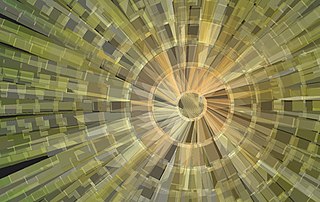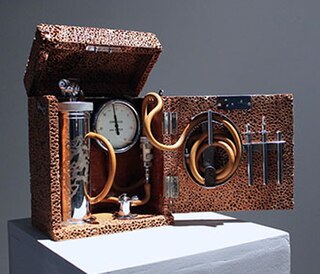
Fractal art is a form of algorithmic art created by calculating fractal objects and representing the calculation results as still digital images, animations, and media. Fractal art developed from the mid-1980s onwards. It is a genre of computer art and digital art which are part of new media art. The mathematical beauty of fractals lies at the intersection of generative art and computer art. They combine to produce a type of abstract art.
Software art is a work of art where the creation of software, or concepts from software, play an important role; for example software applications which were created by artists and which were intended as artworks. As an artistic discipline software art has attained growing attention since the late 1990s. It is closely related to Internet art since it often relies on the Internet, most notably the World Wide Web, for dissemination and critical discussion of the works. Art festivals such as FILE Electronic Language International Festival, Transmediale (Berlin), Prix Ars Electronica (Linz) and readme have devoted considerable attention to the medium and through this have helped to bring software art to a wider audience of theorists and academics.

Electronic art is a form of art that makes use of electronic media. More broadly, it refers to technology and/or electronic media. It is related to information art, new media art, video art, digital art, interactive art, internet art, and electronic music. It is considered an outgrowth of conceptual art and systems art.
Information art, which is also known as informatism or data art, is an art form that is inspired by and principally incorporates data, computer science, information technology, artificial intelligence, and related data-driven fields. The information revolution has resulted in over-abundant data that are critical in a wide range of areas, from the Internet to healthcare systems. Related to conceptual art, electronic art and new media art, informatism considers this new technological, economical, and cultural paradigm shift, such that artworks may provide social commentaries, synthesize multiple disciplines, and develop new aesthetics. Realization of information art often take, although not necessarily, interdisciplinary and multidisciplinary approaches incorporating visual, audio, data analysis, performance, and others. Furthermore, physical and virtual installations involving informatism often provide human-computer interaction that generate artistic contents based on the processing of large amounts of data.

Algorithmic art or algorithm art is art, mostly visual art, in which the design is generated by an algorithm. Algorithmic artists are sometimes called algorists.
BioArt is an art practice where artists work with biology, live tissues, bacteria, living organisms, and life processes. Using scientific processes and practices such as biology and life science practices, microscopy, and biotechnology the artworks are produced in laboratories, galleries, or artists' studios. The scope of BioArt is a range considered by some artists to be strictly limited to "living forms", while other artists include art that uses the imagery of contemporary medicine and biological research, or require that it address a controversy or blind spot posed by the very character of the life sciences.
Melinda Rackham is an Australian writer, artist and curator.

Mel Alexenberg is an American-Israeli artist, art educator, and writer recognized for his pioneering work exploring the intersections of art, science, technology and digital culture. He experimental with digital fine art prints in the 1980s that are in 30 museum collections worldwide, circumglobal cyberangel flights honoring Rembrandt in 1989 and in 2019.

Edward A. Shanken is an American art historian, whose work focuses on the entwinement of art, science and technology, with a focus on experimental new media art and visual culture. Shanken is Professor, Arts Division, at UC Santa Cruz. His scholarship has appeared in numerous journals and anthologies and has been translated into many languages. Shanken is the author of Art and Electronic Media, among other titles.
Judy Malloy is an American poet whose works embrace the intersection of hypernarrative, magic realism, and information art. Beginning with Uncle Roger in 1986, Malloy has composed works in both new media literature and hypertext fiction. She was an early creator of online interactive and collaborative fiction on The WELL and the website ArtsWire.
Kate Armstrong is a Canadian artist, writer and curator with a history of projects focusing on experimental literary practices, networks and public space.
Wendy McMurdo specialises in photography and digital media. In 2018 she was named as one of the Hundred Heroines, an award created by the Royal Photographic Society to showcase global female photographic practice.

Anna Dumitriu is a pioneering visual artist based in Brighton, England, specialising in BioArt. Her installations, interventions and performances use digital, biological and traditional media including bacteria, digital technology and craft techniques, working with diverse audiences.

New media art includes artworks designed and produced by means of electronic media technologies. It comprises virtual art, computer graphics, computer animation, digital art, interactive art, sound art, Internet art, video games, robotics, 3D printing, immersive installation and cyborg art. The term defines itself by the thereby created artwork, which differentiates itself from that deriving from conventional visual arts such as architecture, painting or sculpture.

Victoria Vesna is a professor and digital media artist. She is known for her feminist video, computer and internet art and has been active since the early 1980s. Along with collaborator Jim Gimzewski she is thought to have created one of the first interactive artworks related to nanotechnology and defines her art practice as experimental research.
Nina Sellars is an artist and Research Fellow at the Alternate Anatomies Lab, School of Design & Art, Curtin University, Perth, Western Australia. Sellars describes her artwork as focused on "human anatomy and its symbiotic history with arts and technology." Sellars is also an Adjunct Lecturer at the Department of Anatomy & Developmental Biology, Monash University, Melbourne, Australia and the Project Manager for Immersive Environments at the School of Design & Art, Curtin University, where she designs augmented reality/blended reality teaching spaces that are informed by visual arts practice.

Mona Chalabi is a British data journalist, illustrator, and writer of Iraqi descent, known for her publications with The New York Times and The Guardian.

Addie Wagenknecht is an American artist and researcher living in New York City and Liechtenstein. Her work deals primarily with pop culture, feminist theory, new media and open source software and hardware. She frequently works in collectives, which have included Nortd Labs, F.A.T. lab, and Deep Lab. She has received fellowships and residencies from Eyebeam, Mozilla, The Studio for Creative Inquiry at Carnegie Mellon University and CERN.
Ghislaine Boddington is a British artist, curator, presenter and director specialising in body responsive technologies, immersive experiences and collective embodiment, pioneering it as 'hyper-enhancement of the senses' and 'hyper-embodiment' since the late 80s.

Amy Karle is an American artist, bioartist, and futurist whose work focuses on the relationship between technology and humanity, specifically how technology and biotechnology impact health, humanity, society, evolution, and the future. Karle combines science and technology with art and is known for using living tissue in her work.












